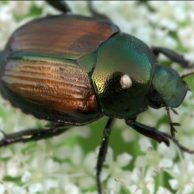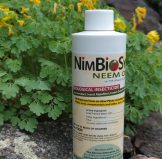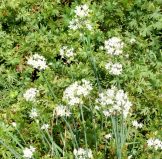
Japanese Beetle is an invasive insect pest that feeds on over 300 different plants. It emerges from a grub stage in the ground in late June, peaks around mid-July and continues until early September. There are no natural enemies for Japanese Beetle in the US, and no one seems to have a successful strategy for eliminating them. We recommend a cumulative approach which combine to be helpful.
We have stopped selling the BeetleGone and GrubGone because they are so expensive and only partially control beetles in your yard, and beetles fly in from the neighbors and beyond. We also don’t recommend Milky Spore, because it doesn’t seem to be effective in Colorado. Nematodes can work, but must be applied at just the right time and often require repeated applications.
Here are some methods we do suggest; we hear it is better to start early in the season before the beetles make attracting chemical trails:
- Hand-collecting: very laborious and effective. Hold a container of soapy water under the beetles and tap them in. You can also use a one gallon jug with 2” of soapy water with a 6” funnel inserted in the top. Hold underneath and tap in. This is often more effective, fewer get away. Morning collection works better when the beetles are sluggish.
- Wild West Method: fill a quart spray bottle with water and a capful of Dr. Bronner’s soap. Turn the sprayer to a single stream and shoot them down. Supposedly faster and does kill the beetles.
 Spray the plants with Neem: neem is a non-toxic herb with insecticidal and fungicidal properties. It acts as an antifeedant, meaning the beetles don’t like to eat it, and if they do, their eggs will not live to the adult stage. Follow the directions using warm water and spray in the cool of the day. It is an oil, so don’t apply too often or it can affect plant respiration.
Spray the plants with Neem: neem is a non-toxic herb with insecticidal and fungicidal properties. It acts as an antifeedant, meaning the beetles don’t like to eat it, and if they do, their eggs will not live to the adult stage. Follow the directions using warm water and spray in the cool of the day. It is an oil, so don’t apply too often or it can affect plant respiration.- Trapping: I know, I know: reputable sources claim traps attract more than they catch. But we have many reports and our own experience indicating that they reduce numbers with less labor than collecting. We learned our method from an East Coast teacher: skip the plastic traps which are expensive, stink, are hard to clean and must be thrown away every year. We recommend: Get a 5 gallon bucket, stick the adhesive bait on the inside of the bucket, 2”-3” down from the upper lip, put 3” of soapy water in the bottom. The beetles will hit the side of the bucket and fall into the water. Use a sieve to scoop out the beetles once a week and replace the water as needed. It’s easy, doesn’t stink and you reuse the bucket. If it is a bad infestation, use a new second bait mid-season. An improvement we learned is to site the bucket on the west side of the property, because the beetles usually fly in on the wind from the west and will get to the trap before they get to your roses or grapes. Let us know if it works for you.
- Garlic Barrier and Mosquito Barrier: Garlic is strong medicine and most insects don’t like it. The smell goes away soon, but not to insects. Spray in the morning or evening in the summer. It will also reduce aphids and spider mites.
- Remove flowers: when the beetle damage starts to get bad, remove the flowers and buds, and keep at it. These flowers will be damaged anyway, and promptly removing the closed buds will remove the main attraction and save the energy of the plant. Then, when beetle numbers have decreased, stop removing the buds and you will have a glorious late season bloom.
-

Garlic Chives, plant with Roses
Plant spring blooming roses/flowers that are finished blooming by mid- June/early July (like spring-blooming heirloom and species roses).
- Remove plants that are magnets to the beetles like Virginia Creeper, Morden Sunrise Rose etc.
- Row-cover Fabric: after fruit has started to form on veggies and berries, cover with light-weight pest-fabric.
- Plant garlic, thyme, annual geraniums etc with your roses or plants that are being eaten. We’ve had reports of success.
- Don’t spray toxic chemicals, because they will kill or weaken your beneficial insects, birds, pets, kids, you or your soil life.
